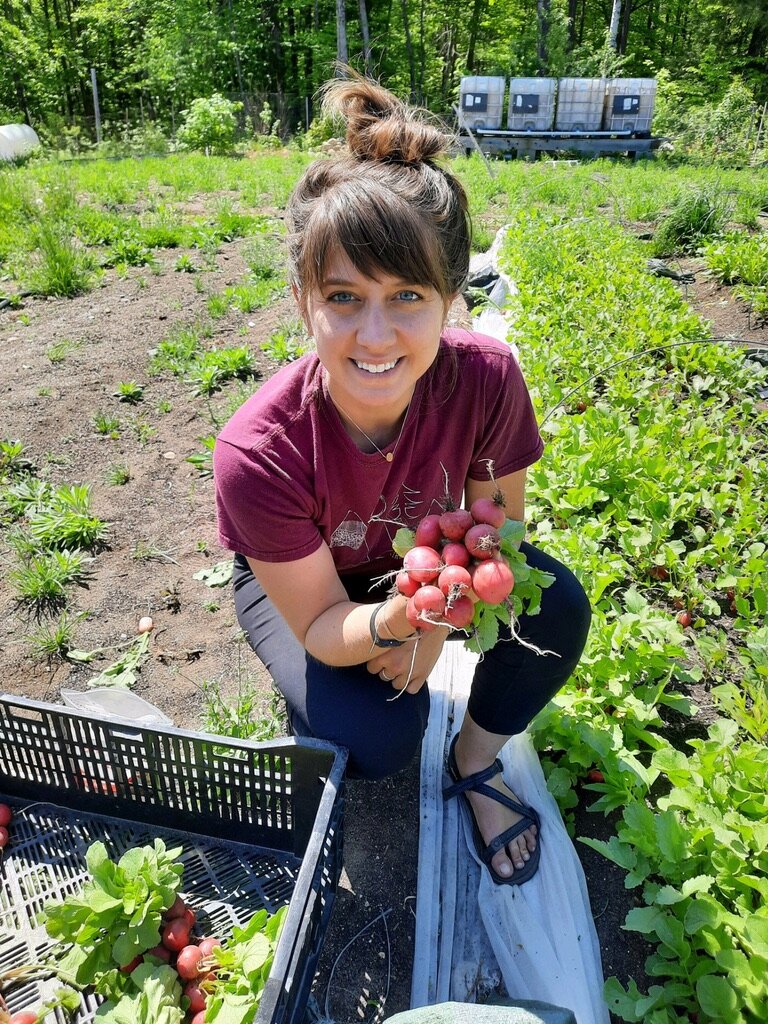Community gardens—defined loosely as shared green spaces that are communally tended—seem to be popping up everywhere lately, including three new gardens right here in Bradford. But what exactly are they? And what do they have to do with the Kearsarge Food Hub?
A Brief History
Smithsonian Gardens describes the first community garden in the United States as an effort by the mayor of Detroit to combat hunger brought on by the economic recession of the 1890s. The vacant lot gardens, known as “[Mayor] Pingree’s Potato Patches,” came with seeds, tools, and growing instructions printed in three languages for the city’s largely Polish and German immigrants.
An 1896 photo of Mayor Pingree (fourth from the left) and others in “Pingree’s Potato Patches” (Accessed from https://communityofgardens.si.edu/exhibits/show/historycommunitygardens/vacantlot)
The success of Mayor Pingree’s program inspired other efforts around the country. One such effort was spearheaded by an early advocate of school gardens, Fannie Griscom Parsons, who in 1902 turned a desolate dumping-ground near NYC’s Central Park into orderly rows of plots called the “Children’s School Farm.” Unlike the efforts in Detroit, Parsons emphasized process over product; with little mention of what happened to the produce, the gardens were managed and tended by school children in order to have them develop values like cooperation, self-respect, and good citizenship.
The program was hailed a great success, and Parsons went on to direct the newly-created Bureau of School Farms before becoming involved in the victory garden movement that emerged during World War I (1914-1918). Originally called “war gardens” or “liberty gardens,” President Wilson called on Americans to help ward off potential food shortages during the war by planting gardens wherever possible, and Americans took up the call. Such efforts were redoubled during World War II (1941-1945), and in 1943, 40% of America’s produce was grown in victory gardens.
I wonder, though, if Smithsonian Gardens didn’t define community garden too narrowly in trying to identify the first one in the United States.
I’d be remiss not to acknowledge the agricultural practices of this land’s Indigenous peoples, who have been present for millennia. Techniques and crops of course varied among Native nations, but the communal tending of crops seems likely the norm. According to Christina Gish Hill, an associate professor of anthropology at Iowa State University, one facet of the US government’s systematic removal of Indigenous peoples from their land was allotment policies, which “assigned small plots to nuclear families, further limiting Native Americans’ access to land and preventing them from using communal farming practices.” (Read that piece, “Regrowing Indigenous Agriculture Could Nourish People, Cultures and the Land,” here.)
Then there was the gardening practiced by enslaved African Americans in order to supplement their often meager and non-nutritious provisions. Charles Ball, a former enslaved man, describes in his 1853 book Slavery in the United States, what are often termed “slave gardens”; “the people are allowed to make patches, as they are called—that is gardens, in some remote and unprofitable part of the estate, generally in the woods, in which they plant corn, potatoes, pumpkins, melons, [etc.] for themselves” (p. 128). According to Ball, each family often had their own garden space; likely, such family units included extended family, and tending tasks were shared among the group.
Common-sense tells us that the practice of growing food cooperatively in shared spaces far pre-dates the term community garden, and though the modes and outcomes have varied, a central through-line remains: these spaces help us nourish our connections with our community, with each other, and with the earth.
Many Shapes and Many Names
Common community garden models, which are often meshed and combined, are as follows.
Plot-based community gardens are what usually come to mind when we think of community gardens. These gardens simply provide people with access to a plot of land. Tools and other resources are often shared, but plots are tended individually and produce is kept by the grower.
At collective gardens, community members work together to tend one large garden, and growers share what they produce. Extra emphasis is usually placed on connection, skill-sharing, and community-building. A great local example of this type of gardening is GrowTeams, a program by ShiftMeals, in Vermont.
Educational or teaching gardens are gardens at which the main purpose is education. These are common at schools, where growing food is secondary to learning, exploration, and experimentation.
At victory gardens (also called donation gardens or giving gardens), the goal is to grow as much food as possible for those who need it. Whether the gardens are managed by one person or by a team of volunteers, the produce is donated to food banks or otherwise distributed to whomever needs it. These gardens not only increase local food security but they provide what can be rare at food banks—fresh, local produce straight from the ground.
Help-yourself gardens and edible landscaping are two sides of the same garden-coin; the food grown in these spaces (garden plots, window boxes, fruit trees in parks, etc.) is available to anyone and everyone, food insecure or not. They are often situated in areas with heavy foot traffic and usually feature signs that inform passers-by of what is ready to harvest. Examples of this type of gardening include Edible Brattleboro and the Upper Valley Apple Corps.
The new victory garden at Bradford’s food pantry, summer 2021 (Photo credit: Julie Loosigian)
The Gardens of the Food Hub
Victory gardens once again made their way to the forefront during the COVID-19 pandemic. Victory gardens (and community gardens in general) exist at the confluence of food sovereignty and security, learning, and community; they fit seamlessly with the mission of KFH, which is to reinvigorate our community within a restorative local food system through cultivating food sovereignty, growing engaged learners, and nurturing community.
The timing was right and the movement was a perfect fit, so in the spring of 2020, KFH, together with the other members of the FEED (food expansion, education, and distribution) Kearsarge Partnership, helped bring the victory garden movement to Bradford.
Through a program called the Victory Garden Revival, three new victory gardens in Bradford were constructed. These gardens were situated in key community areas, including at the food bank and the elementary school. The gardens were supplied with plants through another FEED Kearsarge program, Tray it Forward, through which the partners distribute free trays of seedlings to those in need and community gardens in the Kearsarge and surrounding area.
The victory gardens in Bradford were established not only to help increase local food security, they have secondary goals, including to bolster community members’ ability to grow their own food. This dynamism is common in community gardens, where one space often serves more than one purpose, and structure, participants, terminology, designs, and sizes can vary greatly from garden to garden.
We’re still navigating how these gardens can best serve our community. True to our guiding values, we are always learning as we grow! We’re working closely with our partners to identify the needs of folks throughout the community, and co-creating unique programs to meet those needs. Stay tuned for updates on this ongoing work!
As a nonprofit organization, community supporters make this work possible. Please consider making a contribution today!
Written by Julie Loosigian



